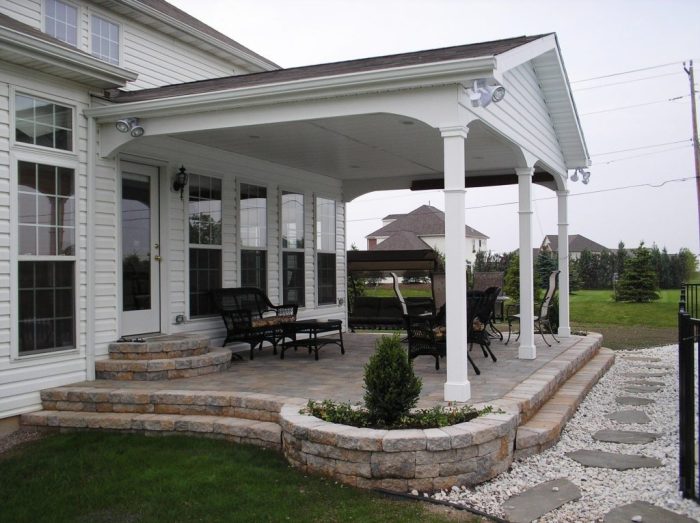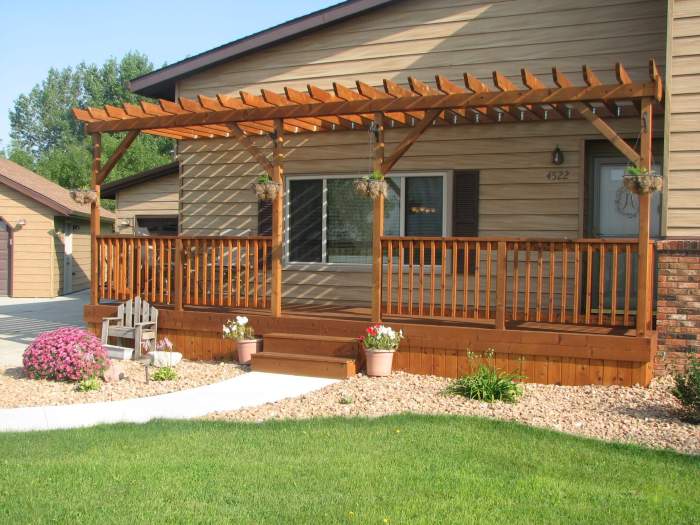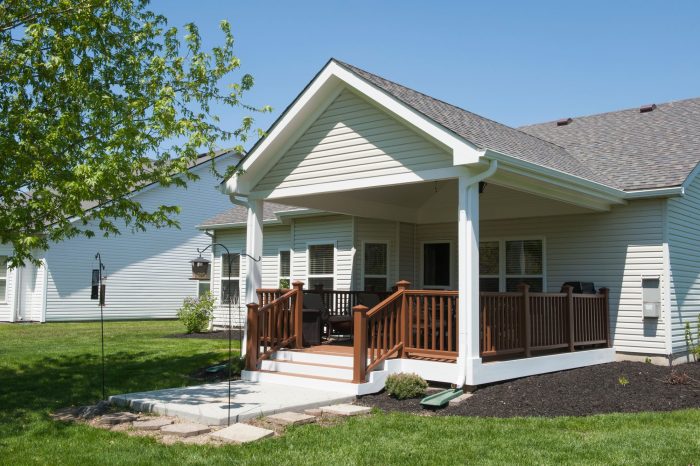Imagine extending your living space into the great outdoors with a charming covered porch. Not only does it enhance your home’s curb appeal, but it also creates an inviting sanctuary where you can relax, entertain, and enjoy the fresh air.
In this comprehensive guide, we will delve into the intricacies of adding a covered porch to your house, empowering you with the knowledge to embark on this transformative project.
Whether you envision a cozy retreat or a grand extension of your living area, we will explore the architectural considerations, structural planning, material selection, and design elements involved in creating a covered porch that perfectly complements your home’s style and meets your needs.
Architectural Considerations
Adding a covered porch to your home can significantly impact its exterior design. It can enhance curb appeal and complement the existing architecture, creating a cohesive and visually appealing facade.
The design of the porch should complement the architectural style of your home. For example, a Victorian-style home might feature a wrap-around porch with ornate gingerbread trim, while a modern home might have a sleek and minimalist porch with clean lines and simple details.
Porch Design Examples
- Gable-front porch: A traditional porch design with a triangular roofline and a gable at the front. This style is common in Colonial and Victorian homes.
- Hip-roof porch: A porch with a roof that slopes down on all four sides. This style is often seen in Craftsman and Bungalow homes.
- Shed-roof porch: A porch with a roof that slopes down on one side. This style is common in modern and contemporary homes.
- Gambrel-roof porch: A porch with a roof that has two slopes on each side. This style is often seen in Dutch Colonial homes.
- Flat-roof porch: A porch with a roof that is flat. This style is common in modern and contemporary homes.
Structural Planning
Adding a covered porch requires careful structural planning to ensure stability, durability, and integration with the existing structure. The following considerations are crucial:
Materials and Foundation Design
The choice of materials for the porch structure depends on factors such as budget, aesthetics, and local building codes. Common materials include wood, vinyl, and composite decking. The foundation design must provide adequate support for the porch and prevent settlement or shifting.
This may involve concrete footings, piers, or a combination of both.
Integration with Existing Structure
The porch should be securely attached to the existing structure to prevent structural damage or collapse. This requires proper framing, including beams, columns, and joists. The connection points must be reinforced to withstand wind and snow loads.
Drainage and Ventilation
Proper drainage is essential to prevent water damage to the porch and the house. Gutters and downspouts should be installed to divert rainwater away from the structure. Adequate ventilation is also crucial to prevent moisture buildup and rot. Vents or screens can be incorporated into the porch design to allow for air circulation.
Material Selection
The choice of materials for your covered porch is a crucial decision that will impact the aesthetics, durability, and maintenance requirements of your outdoor space. Here’s a comprehensive overview of commonly used materials and their advantages and disadvantages:
Wood
- Advantages:
- Natural beauty and warmth
- Versatile and customizable
- Durable with proper maintenance
- Disadvantages:
- Higher cost than some other materials
- Requires regular sealing and staining
- Susceptible to rot and insect damage
Vinyl
- Advantages:
- Low maintenance and easy to clean
- Affordable and durable
- Available in a wide range of colors and styles
- Disadvantages:
- Can fade over time
- Not as natural-looking as wood
- May expand and contract with temperature changes
Stone
- Advantages:
- Highly durable and low-maintenance
- Adds a touch of elegance and sophistication
- Fire-resistant
- Disadvantages:
- Expensive to install
- Can be slippery when wet
- Difficult to repair or replace
Other Materials
Besides the primary materials mentioned above, you may also consider other options such as:
- Composite decking: A durable and low-maintenance alternative to wood, made from a blend of wood fibers and plastic.
- Metal: A strong and long-lasting material, but can be noisy and hot to the touch.
- Glass: Provides an open and airy feel, but can be expensive and requires special care.
The choice of material ultimately depends on your budget, lifestyle, and desired aesthetic. By carefully considering the advantages and disadvantages of each option, you can select the perfect material to create a covered porch that enhances the beauty and functionality of your home.
Design Elements
A covered porch is not just a roof over your head; it’s an extension of your living space, a place to relax, entertain, and enjoy the outdoors. The right design elements can transform your covered porch into a welcoming and comfortable oasis.
Consider the following design elements to enhance the functionality and appeal of your covered porch:
Railings
Railings provide safety and define the space of your porch. Choose railings that complement the style of your home and porch. Consider using materials such as wood, metal, or glass to create a unique look.
Columns
Columns support the roof of your porch and add a touch of elegance. Choose columns that are proportionate to the size of your porch and that match the architectural style of your home.
Lighting
Lighting is essential for creating a welcoming and safe porch. Use a combination of overhead lighting and accent lighting to illuminate your porch. Consider using dimmers to create a cozy atmosphere.
Furniture
The furniture you choose for your porch should be comfortable and weather-resistant. Choose pieces that are made from materials such as wicker, teak, or aluminum. Consider adding cushions and pillows for extra comfort.
Inspiration
Here are a few examples of well-designed covered porches to inspire you:
- A porch with a vaulted ceiling and exposed beams creates a spacious and inviting atmosphere.
- A porch with a fireplace provides a cozy and warm place to relax.
- A porch with a screened-in enclosure keeps out insects and provides a comfortable place to enjoy the outdoors.
Cost and Value
Adding a covered porch to your home can be a worthwhile investment that enhances its value and livability. The average cost of adding a covered porch ranges from $15,000 to $30,000, depending on the size, materials, and complexity of the design.
Factors that can affect the cost include:
- Size: The larger the porch, the higher the cost.
- Materials: The type of materials used for the porch floor, roof, and railings can impact the cost.
- Complexity of the design: A porch with a simple design will cost less than a porch with a more elaborate design.
Potential Return on Investment
Adding a covered porch can increase the value of your home. A well-designed porch can add curb appeal and make your home more attractive to potential buyers. In addition, a covered porch can extend your living space and make your home more enjoyable to live in.
This can lead to a higher return on investment when you sell your home.
Building Process
Constructing a covered porch entails a series of meticulous steps, each contributing to the final structure’s durability and aesthetic appeal. From meticulous planning and design to expert construction and finishing touches, this comprehensive guide will delve into the intricate process of building a covered porch, ensuring a successful outcome.
The initial stage involves meticulous planning, where the porch’s design, dimensions, and materials are carefully considered. Architectural drawings and blueprints serve as the foundation for the project, ensuring structural integrity and compliance with building codes.
Foundation and Framing
The foundation, the cornerstone of the porch, is typically constructed from concrete footings and piers, providing a stable base for the structure. Framing, the skeletal framework of the porch, is meticulously assembled using pressure-treated lumber, creating the walls, roof, and any decorative elements.
Roofing and Siding
The roof, an essential component of the porch, protects against the elements. Roofing materials, such as asphalt shingles or metal panels, are carefully installed, ensuring watertightness and durability. Siding, the exterior cladding of the porch, not only enhances its appearance but also safeguards against moisture and weather damage.
Flooring and Railings
The flooring, the surface upon which you walk, is meticulously laid using durable materials such as concrete, pavers, or wood decking. Railings, the safety barriers along the perimeter of the porch, are installed to prevent falls and enhance accessibility.
Finishing Touches
The final stage involves adding the finishing touches that transform the porch into an inviting and functional space. Lighting fixtures illuminate the porch, extending its usability into the evening hours. Ceiling fans provide ventilation and a cooling breeze. Decorative elements, such as trim, molding, and paint, complete the porch’s aesthetic appeal.
Last Recap
Adding a covered porch to your house is a rewarding investment that enhances your living space, increases your home’s value, and creates a lasting legacy for your family. By carefully considering the architectural, structural, and design aspects Artikeld in this guide, you can transform your home into an oasis of comfort and beauty.
Embrace the opportunity to create an outdoor haven that will provide countless moments of joy and relaxation for years to come.



